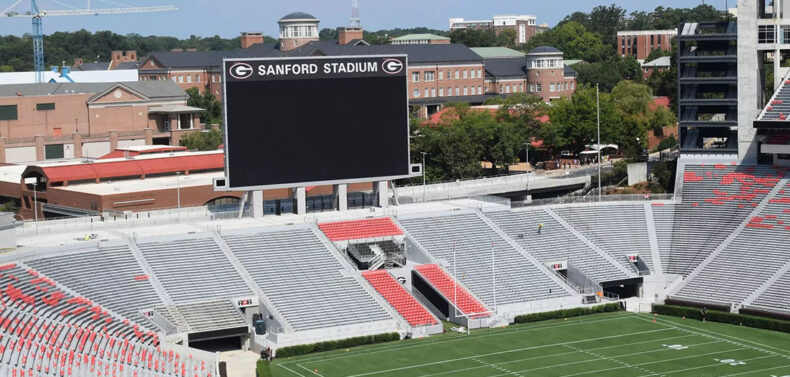The University of Georgia Athletic Association’s coffers have swollen in the decade since Kirby Smart became football coach, fueling an athletic construction boom approaching half a billion dollars. But the nonprofit corporation that runs UGA’s college sports programs is scratching for more as they fight to stay on top of the arms race that is college football.
Some college athletic operations rake in more dollars than UGA, but when it comes to the bottom line, they’re not in UGA’s league. The University of Texas, for example, reported revenue of $331.9 million—$91 million more than UGA—but $325 million in expenses in the 2024 fiscal year, according to The New York Times‘ “The Athletic”; Ohio State reported a small deficit despite $292 million in revenues, in part because Ohio State and other Big Ten colleges sponsor more “non-revenue” sports, which cost more to run than they generate in income, than UGA and other Southeastern Conference schools. Ohio State runs 36 NCAA Division I teams to UGA’s 21.
In recent years, Georgia’s surpluses have soared to previously unthinkable heights. UGA’s athletic income doubled in Smart’s first eight years, and with football ticket prices going up and new Southeastern Conference media deals now kicking in, UGA revenues are set to continue their upward climb.
UGA’s athletic operating revenues reached $241.8 million in the 2024 fiscal year ending June 30, 2024 (the latest year for which reports are available) against $194.3 million in operating expenses—a difference of $47.3 million, or nearly 25%.
In the five fiscal years from 2019–2024, the athletic surplus has averaged $38.4 million per year. The UGAA even had a surplus in the 2021 fiscal year, when ticket sales in the COVID-constrained 2020 football season plummeted to $4.7 million from $38.6 million in 2019. Thanks to an infusion of money from the SEC, a remarkable return on the athletic association’s investments, and about $16 million less in expenses, the athletic association still managed a $46.4 million surplus in FY2021.
The money comes from four main sources. Ticket sales were $39.5 million in FY24 (mainly football tickets, $36.6 million), and media rights, mostly for football and men’s basketball TV, yielded $43.6 million. Royalties, licensing and advertising added another $23 million, but by far the biggest chunk was a remarkable $101.3 million in “contributions.” Much of the annual contribution money is cash ticket-buyers pay in addition to the ticket face price—more money gets you better seats.
Football usually accounts for most of the contribution line, with men’s basketball a distant second, but not in FY 2024. The men’s and women’s tennis teams each recorded $11.5 million in contributions for FY 2024, enough to pay for several years of their typical operating costs; the women’s softball team got $14.3 million in contributions; and baseball recorded $8.6 million. Football contributions were $42.7 million in FY24, and men’s basketball generated $3.3 million.
At schools with big-time athletic programs, the general expectation is that football will bring in more money than it costs, and men’s basketball likewise on a smaller scale. Their excess income goes to subsidize all the other teams—women’s basketball, men and women’s golf, volleyball, gymnastics and others that cost more to run than the revenue they generate.
Women’s basketball at UGA cost $6 million in FY24, for example, against $2.9 million in overall income, including $1.5 million in contribution income. Women’s basketball and perhaps gymnastics and softball are short-changed in a way, however. Despite the tremendous rise in TV viewership for women’s sports, particularly basketball, UGA only recorded $15,047 in media rights income each for basketball and other women’s teams, thanks to the terms of league media contracts. UGA reported $4.9 million revenue for men’s basketball media rights and $20.2 million for football.
On the expense side, the biggest cost is coaching salaries and benefits: $40.7 million in FY2024, followed by support staff at $36.6 million. Football coaching salaries were reported as $23.6 million, including $12.1 for the head coach and $11.6 million for assistant coaches, some of whom now earn more than $1 million. In the 2017 fiscal year, Smart’s first, football coaches’ pay totaled $13.5 million.
Other FY24 expenses included $12.4 million in school scholarships for the “athletic aid equivalency” of about 200 full-time athletes, about an equal number of men and women. (In some sports, coaches can split the money into partial scholarships.) Other big-ticket expense lines were $25.8 million in administrative costs, $10 million for team travel, $10.1 million for game expenses, $4.2 million for student-athlete non-travel meals and $6.4 million for recruiting. Rental and debt service costs were $11.4 million, mostly in debt service. The athletic association listed total athletic debt of $117.6 million in FY24, down from $136.4 million a year earlier.
As a tax-exempt 501(c) non-profit corporation, the athletic association doesn’t have stockholders or pay dividends from its profits. The UGA president controls a majority of appointments to its governing board; under NCAA rules, college athletic programs must be under the authority of their university administrations.
Some of the UGAA’s surplus annual revenue gets invested in athletic endowment funds that reached $131.2 million in FY24, and coaching salaries have roughly doubled, but by far the biggest part has been devoted to building new athletic facilities, starting with an indoor football practice field in 2017. The most recent projects include the $60 million track and field complex now going up on South Milledge Avenue and the subsequent $56 million conversion of the existing track and field facility near Stegeman Coliseum into more football practice fields and 168 parking spaces.
The athletic association has budgeted close to half a billion dollars in construction since 2017, including $80 million for a football operations building, around $150 million for improvements in Sanford Stadium, along with a $45 million upgrade to UGA’s baseball field and $38.5 million at its softball stadium across South Milledge Avenue from where the new track facility is rising.
One new expense this year is paying players. After athletes sued to get paid for their work, schools are now allowed to pay players up to a total of $20.5 million a year, in addition to full-ride college scholarships. Neither UGA nor other schools have revealed how the money will be divided up among sports and players, saying that for one reason or another it’s not public information.
One result of the legal settlement between athletes seeking pay and the NCAA is that the so-called “collectives” that UGA and other schools had been using to funnel NIL money to athletes are being shut down. Athletes will still be able to negotiate NIL deals with outside entities, but such contracts must now be approved as legitimate, not just a pay-for-play deal, by a special commission the NCAA has set up.
The new pay rules seem likely to widen the gap between the haves and have-nots of college sports, including some big-time programs like UCLA, with a reported $200 million deficit in five years despite $30 million in annual student fees and “direct institutional support.”
Athlete pay is an even bigger reach for smaller athletic programs such as Kennesaw State and Georgia Southern, with reported revenues of around $40 million, most of it from institutional funds and student fees. Austin Peay and Marshall University, two of UGA’s small-school football opponents this year, respectively reported $21 million and $48 million in athletic revenue in FY24, mostly from institutional support and student fees.
Despite the association’s prosperity, it’s not enough for the future, according to its administrators, who are looking for more ways to drive revenue, as they call it. One of the athletic association’s fastest-growing revenue categories is “other,” which more than quadrupled from $1.4 million in 2014 to $6.6 million in FY24. In April, the association will rent out Sanford Stadium for a music concert, with the artists and terms yet to be named. (Vince Dooley once turned down a young UGA cultural affairs workers’ idea of booking a Sanford Stadium concert with Bruce Springsteen when the Boss was riding high.) Once in 2013, the field became a music stage, and 66,000 people came to hear a country music lineup. A Sanford concert by Athens’ R.E.M. has been a source of speculation for years, but other big acts—imagine Taylor Swift—would bring lots of business to downtown Athens.
The association is also making money this year selling “Game Day Experiences.” For just $1,500 per quarter in the Alabama game ($2,000 for the fourth quarter), you could descend from the stands to cheer on the dogs from the north sideline, up close and personal. For $3,000, you could run onto the Dooley Field turf with the team as they take the field just before kickoff, feeling what it’s like to bask in the deafening roar of the Bulldog faithful who’ve filled most of Sanford Stadium’s 93,303 seats. Among other opportunities, $5,500 would buy a child the privilege of running onto the field to fetch the tee after each kickoff. Those with more modest budgets might buy a greeting on the stadium’s huge message board—$150 for the Alabama game, up from the $100 Austin Peay fee.
One recent weeknight, the big Sanford Stadium lights pierced the dark like strobes and swept back and forth across the empty field and stands for anyone pausing to watch from the bridge at the stadium’s west end. Brilliant green LED strips at the bottom of the upper deck urged viewers to buy the Georgia Lottery’s new Georgia Bulldog scratch-off game, featuring an image of Uga, Georgia’s Bulldog mascot. “Win big!” the banner urged.
Meanwhile, Sanford Stadium’s seating capacity has dropped to ninth place among U.S. college stadiums as other schools spend billions to enlarge their stadium sizes to 100,000 and beyond. Can talk of adding seats in Stanford’s north end, completing the bowl, be far away?
Like what you just read? Support Flagpole by making a donation today. Every dollar you give helps fund our ongoing mission to provide Athens with quality, independent journalism.










